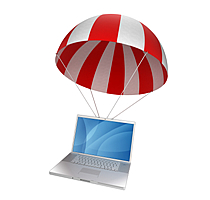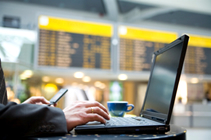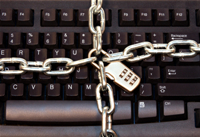Posts Tagged ‘Tips’
Friday, October 22nd, 2010
 Hey, everyone, Josh from Computer Fitness back with another award-winning article to help you with your computer conundrums. Hey, everyone, Josh from Computer Fitness back with another award-winning article to help you with your computer conundrums.
PC Backups are an important part of computer ownership. Just keeping a copy of your files is a great start. However, there are often programs that get left behind if you only save your media. Software backups vary as to what they offer, but an invaluable tool is PC Imaging software.
Think of this like a camera. The software will take a “picture” or image, on your machine, which you can use later. The image, in this case, contains everything on your computer at that point. Later, if you need to restore your PC’s files to another machine, you can practically pick up from where you left off.
Another valuable use of this technology is to create a template for new machines. If you run a small to medium sized business, odds are that you use similar or identical PCs in your office. In this case, your IT folks can configure the machines are necessary using a singular image file. This makes turn around much faster on broken machines.
Some software solutions to help you out with this are Norton Ghost for PCs and Time Machine for Mac OS X. Time Machine is included with all Macs made since 2008.
-Josh
Computer Fitness

Tags: backups, Information Security, Software, Tips, tools
Posted in Mac and PC | No Comments »
Thursday, September 23rd, 2010
 Hey, everyone, Josh from Computer Fitness back with another award-winning article to help you with your computer conundrums. Hey, everyone, Josh from Computer Fitness back with another award-winning article to help you with your computer conundrums.
So your Windows machine is running a little slowly, eh? It happens. Over time, machines just tend to accrue a little wear and tear. Unlike a physical machine, for example, you can’t always crack open the case and just know what part to change. Software is usually at fault for a lot of experience issues, so here are some tips to clean up your PC and get it running like new.
Defragment
We’ve gone over this before. Defragging takes all the bits and bytes on your machine and rearranges them in the proper order. Fragmentation is the reason a lot of programs will open slowly and why finding files can take a lot of time. Your PC has to gather up all the pieces, rather than just pointing to a single location.
Clear Your Cache
Your cache is a gathering of temporary files used by your PC for various reasons. Over time, they build up and your PC can really slow down as a result. The biggest creator of these files is Internet browsing. By clearing out your cache, you can free up precious resources your machine desperately needs. To do this, open up My Computer. Right-Click on your “C:” and hit properties. Click “Tools” and then select Disk Cleanup.
Turn off Visual Effects
If you aren’t hung up on your operating system looking pretty all the time (or don’t have the RAM to back it up), you can disable the cool visual effects in Windows. This is far less taxing your system and as a result, programs will run faster in general. To do this, right click on My Computer and hit Properties. In the bottom left corner of the new window, you should see a link that says “Adjust Visual Effects”. Now, just select “Adjust for Better Performance”. Your machine will process for a minute and then your PC will look reminiscent of Windows 2000, but it will run faster for it.
-Josh
Computer Fitness

Tags: computer, machine, pc, Tips, Tweaks, Windows
Posted in Desktop - Workstation, PC, PC Maintenance, Software | No Comments »
Thursday, June 10th, 2010
 Hello and welcome to Computer Fitness’ Blog! My name is Josh. Computer Fitness is a tech support firm for small and medium businesses in Reisterstown, MD. Our areas of expertise run the gamut from workstation repair to server maintenance. Hello and welcome to Computer Fitness’ Blog! My name is Josh. Computer Fitness is a tech support firm for small and medium businesses in Reisterstown, MD. Our areas of expertise run the gamut from workstation repair to server maintenance.
You’re a businessperson on the go. You travel from place to place to place and therefore live on your laptop and wireless device. You’ve got yourself a laptop and that is a great start. As someone who’s lived through mobile devices for a while, I have some suggestions on travel/laptop accessories for all you travelers.
Bluetooth Mouse
Let’s be honest, most trackpads aren’t up to the challenge of letting you get work done. While there are a few that can make life a little easier, your best bet is to get a Bluetooth mouse to meet your pointer needs. While you could opt for a standard 2.4GHz wireless mouse, the downside there is usually the massive USB dongle you have to plug into your laptop. That makes space a bigger issue. Also, you lose a USB port. However, most modern laptops have Bluetooth built-in. If, for some reason, you don’t have Bluetooth in your laptop, the adapters are so small you barely notice them. Bluetooth devices are a win here.
Lap Desk
This might seem like something you don’t really need, but have you ever really let a laptop sit on your lap for an extended period of time? They tend to get pretty hot, especially if you are doing a lot of processor intensive computing. A lap desk will keep you from burning your legs with your laptop. Plus, you can use the extra space to use your wireless mouse. These are incredibly handy if you’re traveling on a train, etc. for a long amount of time.
Headset with Microphone
While most business can be done on your mobile phone, there are a lot of really cool and free online voice communication programs. Skype comes to mind as the most popular. This program allows you to use your computer as a phone, and call others with the same program or even call real phone numbers for a fraction of the cost. This program is great for international calls and also supports video chat.
That’s all for this week. Come back next week for more computer fitness tips!
-Josh
Computer Fitness
Onsite and Remote Tech Support

Tags: Accessories, Laptop, Mobile, Office, Tips
Posted in Business Travel Tips | 2 Comments »
Thursday, April 22nd, 2010
 Hello and welcome to Computer Fitness’ Blog! My name is Josh. You may know me from the Internet Beacon. We have a pretty cool blog over there. If you’re new to our sites, do check it out; there’s plenty more awesome over there. Computer Fitness is a tech support firm in Finksburg, MD. Our areas of expertise run the gamut from desktop repair to server maintenance. Hello and welcome to Computer Fitness’ Blog! My name is Josh. You may know me from the Internet Beacon. We have a pretty cool blog over there. If you’re new to our sites, do check it out; there’s plenty more awesome over there. Computer Fitness is a tech support firm in Finksburg, MD. Our areas of expertise run the gamut from desktop repair to server maintenance.
Windows User Account Control, or UAC, was introduced in Windows Vista as a way to make the Windows OS more secure. There are a lot of arguments as to whether or not this is true, but the fact remains that it is a part of Windows. Today, let’s examine some of the Pros and Cons of using UAC.
Pro – UAC Prevents Unauthorized Installations and Changes to Your System
UAC does its job here. It will keep changes from happening to your system without your express permission. This includes changing settings on your machine as well as installing software. This is incredibly handy, as a lot of malware gets around computers this way.
Pro – Adjustable Levels of Access
UAC allows you to set varying levels of warning for your computer. This comes in handy if you are always installing new programs or making changes to your PC. You can custom tailor notifications from the UAC in the Control Panel.
Cons – UAC Can Be Intrusive
One of the biggest complaints that users have about UAC is that it can be incredibly intrusive. This was more of a complaint in Windows Vista, but it is valid. Most people don’t know how to change the settings that control UAC, so getting a notification every time you want to do a lot of things on your PC can be very frustrating.
Cons – Too Specific
UAC’s biggest flaw is that it is too granular. The specificity that UAC applies to computer management is more of a hassle than a help. You can unblock one application but a process started by that application may be flagged. This leads to a lot of frustration and unnecessary action on the user’s part when dealing with UAC.
That about wraps up our section on Windows UAC. There is a lot more to this feature and I encourage you to check out more for yourself (see Windows UAC).
-Josh
Computer Fitness
Onsite and Remote Tech Support

Tags: Information Security, Tips, UAC, Windows
Posted in Desktop - Workstation | 1 Comment »
|
 Hey, everyone, Josh from Computer Fitness back with another award-winning article to help you with your computer conundrums.
Hey, everyone, Josh from Computer Fitness back with another award-winning article to help you with your computer conundrums.




 Hey, everyone, Josh from
Hey, everyone, Josh from 



